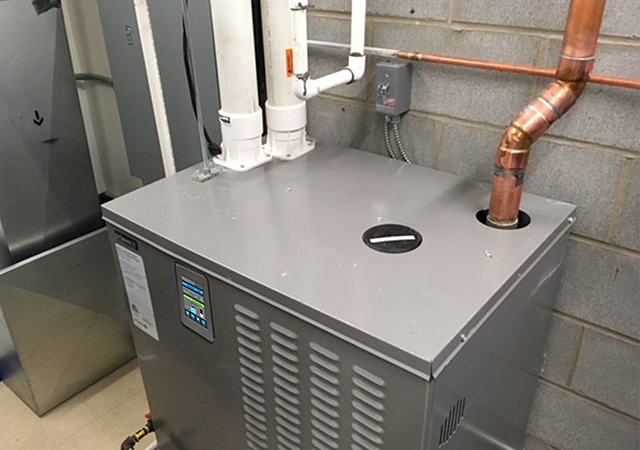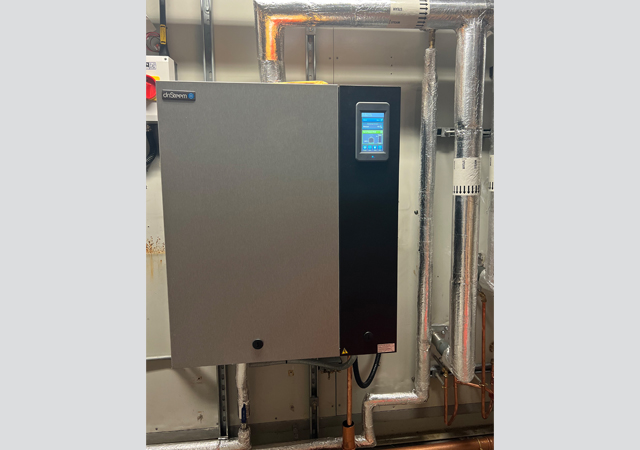
DriSteem’s Adiatec high-pressure atomising systems use heat already present in the air to evaporate evenly distributed water droplets dispersed by the system.
Humidification systems can address IAQ challenges
01 April 2024
Maintaining a comfortable and healthy indoor environment is crucial in the Arabian Gulf, where high temperatures and dry conditions pose unique challenges, says Duncan Curd, DriSteem’s Global Business Development Leader.
In an exclusive interview with Gulf Construction, he sheds light on the role of humidification systems in achieving optimal indoor air quality (IAQ) and occupant comfort.
Elaborating on target humidity levels and how they address specific needs of various buildings, Curd says: “No matter the climate or the building, the recommended indoor relative humidity (RH) level typically ranges from 30 per cent to 60 per cent, according to guidelines published by the American Society of Heating, Refrigerating, and Air-Conditioning Engineers (Ashrae). Keeping RH levels within this range ensures the health and safety of building occupants without promoting mould growth or other indoor air quality issues.”
“Studies have shown that, maintaining indoor relative humidity levels between 40 per cent and 60 per cent can help reduce the survival and transmission of viruses and bacteria,” he adds.
DriSteem offers a range of humidification systems that can be tailored to meet the needs of any environment, including those with high temperatures and dust that are prevalent in the Gulf region. The choice of humidification technology will depend on the facility’s operational requirements, preferred energy source, water quality, and temperature control considerations.
For instance, DriSteem evaporative cooling and humidification systems are energy-efficient and well-suited for the hot and dry climate of the Arabian Gulf, Curd says.
“These systems can be integrated with existing HVAC systems or used independently, making them a versatile solution for buildings that prioritise sustainability and cost-effectiveness,” he points out.
 |
|
Curd ... the recommended RH ranges from 30 to 60 per cent. |
Excerpts of the interview with Duncan Curd:
Given the hot climate of the Arabian Gulf, what are the recommended target humidity levels for different types of buildings to ensure optimal indoor air quality and occupant comfort and health?
No matter the climate or the building, the recommended indoor relative humidity level typically ranges from 30 per cent to 60 per cent RH, according to guidelines published by Ashrae, a professional organisation with chapters worldwide. Keeping RH levels within this range ensures the health and safety of building occupants without promoting mould growth or other indoor air quality issues. Of course, it is important to remember that every building is unique. The type of indoor space, air quality goals, energy source, capacity, etc, will determine the best relative humidity levels for each facility.
What applications are humidifiers generally used for in the region? What benefits do they offer?
Commercial humidification systems are required to support human health, well-being, and comfort, to protect and preserve materials and to ensure productivity and quality. Humidification systems offer indispensable benefits in environments ranging from museums and art galleries to bustling production floors, controlled research laboratories and sensitive hospital facilities.
DriSteem humidification systems are instrumental in maintaining optimal conditions for manufacturing processes in busy production facilities. Their role in preventing product issues such as shrinkage, warping, or degradation due to moisture fluctuations is crucial. Whether it’s electronics, pharmaceuticals or food and beverages, managing relative humidity levels is essential for quality control and operational efficiency.
In research laboratories, DriSteem humidification systems allow researchers to create and maintain specific environmental conditions, ensuring the accuracy and reliability of their experiments. Whether controlling moisture levels for cell culture growth, keeping conditions stable for analytical instruments, or preventing sample contamination, these systems play a critical role in enabling scientific advancements.
Maintaining a healthy indoor environment is crucial for patient well-being and infection control in hospital wards and healthcare facilities. DriSteem humidification systems help create optimal conditions to support patient recovery and comfort while minimising the spread of airborne pathogens. By controlling relative humidity levels within recommended ranges, these systems can help reduce the survival and transmission of bacteria and viruses, contributing to a safer and more hygienic healthcare environment.
 |
|
DriSteem’s GTS humidifier LX Series is said to be the only gas-fired humidifier that combines the highest efficiency on the market with ultra-low NOx in a single design. |
How can humidification systems address the challenges of maintaining consistent humidity levels in variable conditions in the Gulf region?
In general, there are two types of humidification technologies used in commercial applications: isothermal and adiabatic. Isothermal, or steam humidification, increases relative humidity levels by directly adding steam to the air. This is accomplished by heating water to its boiling point, which converts it into steam. The steam is then injected into the air stream, mixing with the surrounding air, and raising the humidity level. These units can be powered by electricity, gas, or boiler steam, offering precise humidity control.
Adiabatic humidification causes water to evaporate and humidify the air. Atomisation systems use high-pressure air to forcibly break down water into tiny particles, creating a fine mist that the air readily absorbs. Adiabatic technology can contribute to energy efficiency and cost savings by cooling the air while providing humidification for a facility. By leveraging this technology, relative humidity levels can be effectively elevated to the desired range, creating a healthier and more comfortable indoor environment while saving energy.
Considering the high temperatures in the region, what factors should homeowners consider when selecting a humidification system for their buildings?
When choosing a humidification system, the decisions that engineers and facility managers make are similar to those that homeowners must consider. Homeowners should opt for a system that can cover the size of the living space, has high energy efficiency ratings, is easy to maintain, integrates with the home’s HVAC system, has adjustable humidity settings, and has proper water management features.
As with commercial systems, working with a humidification system specialist is highly recommended to assess specific needs and recommend the best system that meets requirements. By investing in a high-quality humidification system and maintaining it properly, homeowners can enjoy the benefits of improved indoor air quality and a comfortable living environment while protecting valuable furnishings and finishes.
 |
|
DriSteem RTS electric resistive humidifier … compatible with all water types. |
What are your recommendations for RH levels for different building types, such as offices, healthcare facilities or data centres?
Maintaining optimal humidity levels for different building types is essential to ensure the health and comfort of occupants while preventing damage to materials and equipment. Office environments should aim for 30-60 per cent humidity, while healthcare facilities require strict humidity control to reduce the spread of airborne infections. Data centres maintain humidity levels between 40-60 per cent to prevent electrostatic discharge and protect equipment from damage.
These are just general guidelines, and specific recommendations may vary based on factors such as building design, climate, and the activities conducted within each building type. It’s essential to consult industry standards, building codes, and the expertise of professionals in HVAC and indoor air quality to determine the most suitable humidity levels for a particular environment.
DriSteem representatives based locally in the GCC region have extensive knowledge of the climate and building types in the area.
They can provide guidance on the appropriate humidification solutions, system designs, and control strategies best suited for each building to ensure optimal performance and efficiency while addressing specific needs and concerns.
How do humidification systems address energy efficiency, particularly considering the high cost of cooling in the region?
DriSteem’s commercial humidification systems are equipped with advanced controls that allow for precise monitoring and adjustment of humidity levels. In addition, DriSteem offers humidification solutions specially designed for energy efficiency and sustainability.
Its adiabatic humidifiers offer a promising solution for areas with dry conditions. Using the evaporative cooling principle to humidify the air, these systems provide significant cooling effects without consuming excessive energy. This adiabatic technology can contribute to energy efficiency and cost savings by cooling the air while providing humidification for a facility.
How can humidification systems help mitigate the spread of airborne viruses and bacteria in the harsh climate of the Arabian Gulf?
Studies have shown that, no matter what the climate, maintaining indoor relative humidity levels between 40 per cent and 60 per cent can help reduce the survival and transmission of viruses and bacteria. Humidification systems can regulate humidity levels within this range, creating an environment less conducive to pathogen survival.
Optimal humidity levels can significantly reduce the risk of transmission by influencing the size and behaviour of respiratory droplets expelled when an infected person coughs or sneezes. These levels can cause these droplets to settle more quickly, reducing the distance they can travel and the likelihood of inhalation by others. This means that by properly humidifying the air, we can effectively reduce the spread of viral and bacterial particles, causing them to agglomerate or clump together.
Humidification plays a crucial role in environments where static electricity buildup is a common issue, such as in dry air conditions. It can effectively reduce static charges, thereby minimising the attraction and adhesion of particles, including viruses and bacteria, to surfaces. This comprehensive approach reduces their airborne presence, providing a more health-friendly environment.
How does water quality (mineral content, salinity) affect the selection and operation of humidification systems? Are there any pre-treatment recommendations for the region’s water sources?
Water quality can significantly impact the selection and operation of humidification systems. The effects of water quality on humidification systems vary depending on the type of technology used.
Isothermal steam humidifiers generate steam by heating water. Water quality is critical for steam humidifiers as mineral buildup can lead to scaling and damage to heating elements, valves, and other components. High mineral content can also affect the steam quality, potentially introducing minerals or contaminants into the indoor air. Salinity in water can also lead to corrosion of metal components in steam humidifiers.
Evaporative humidifiers utilise water evaporation to add moisture to the air. High mineral content in water can lead to the buildup of scale and mineral deposits on the humidifier pads or surfaces, reducing the system’s efficiency and potentially causing malfunctions. Additionally, minerals in the water can be released into the air as particulate matter, affecting indoor air quality. Salinity in water can also affect the performance of evaporative humidifiers, particularly if it leads to corrosion of components.
Installing a water filtration system can help remove impurities and minerals from the water before they enter the humidification system. This can reduce the risk of scale buildup and improve the performance and longevity of the system.
If the water source has a high mineral content, a water softening system can reduce the concentration of minerals, such as calcium and magnesium, which are responsible for scale formation. This can help prevent scaling and prolong the life of humidification system components.
Implementing a regular maintenance schedule, including cleaning and descaling of humidification system components, is crucial for ensuring optimal performance and longevity. Regular maintenance helps remove mineral deposits and prevents buildup, allowing the system to operate efficiently.
In some cases, chemical treatment may be necessary to control mineral buildup and prevent corrosion in humidification systems. Water treatment chemicals can help inhibit scale formation and protect system components from corrosion.
Regularly monitoring water quality parameters such as mineral content, salinity, pH, and conductivity can help identify any issues early on and allow for adjustments or interventions as needed. Water quality testing kits or meters can be used to assess the characteristics of the water source.
When selecting a humidification system, it’s essential to consider the characteristics of the water source in the area. If the water quality is poor or there are concerns about mineral content or salinity, choosing a humidification system designed to handle such conditions or implementing appropriate pre-treatment measures is advisable.
What are the recommended maintenance procedures for humidification systems in the Arabian Gulf region, considering the potential for dust and higher temperatures?
To ensure optimal performance and longevity of humidification systems in the Arabian Gulf region, it is recommended to regularly clean the humidifier components, install high-quality air filtration systems, monitor water quality, and inspect for corrosion. Descaling procedures should also be implemented, and pumps and nozzles should be inspected regularly. The operation should be regulated based on ambient conditions with temperature control.
In addition, it’s essential to establish a comprehensive maintenance schedule that includes routine inspection, cleaning, and servicing of the components. Manufacturers’ recommendations for maintenance intervals and procedures should be followed, and detailed records of the maintenance activities should be kept. Additionally, it is advisable to periodically enlist the services of qualified technicians or contractors to identify potential issues, perform specialized maintenance tasks, and ensure systems operate safely and efficiently.
Does DriSteem offer specific humidification systems designed for the unique climate of the Arabian Gulf?
DriSteem’s humidification systems can be tailored to meet the needs of any environment, including those with high temperatures and dust that are prevalent in the Gulf region. The choice of humidification technology will depend on the facility’s operational requirements, preferred energy source, water quality, and temperature control considerations. DriSteem offers a range of options, including electric, gas-fired, steam, and adiabatic humidifiers, to ensure that the needs of each indoor environment are met. A comprehensive consultation with a local DriSteem representative is recommended to ensure the right solution is selected.
How do your humidification systems integrate with existing HVAC systems commonly used in the Arabian Gulf?
DriSteem humidification systems are designed to integrate seamlessly into existing HVAC systems. Integration typically involves coordinating the humidification system with the HVAC system’s controls, airflow, and ductwork to ensure optimal performance and efficiency.
DriSteem systems can be integrated directly into central AHUs commonly used in commercial and industrial buildings. Depending on the type of humidification system, humidifiers can be installed within the AHU or in ductwork downstream of the air handler. Integration often involves coordinating control signals between the humidification system and the AHU’s control system to maintain desired humidity levels.
For buildings with existing ductwork but without central AHUs, DriSteem offers duct-mounted humidification systems that can be installed directly into the ducts. These systems are designed to inject moisture directly into the airflow, ensuring even distribution throughout the building. Integration involves sizing the humidification system to match duct dimensions and airflow requirements.
DriSteem humidification systems can be integrated with building management systems (BMS), commonly used to monitor and control HVAC systems in large buildings. The humidification system can be connected to the BMS network, allowing for centralised control and monitoring of humidity levels, setpoints, and system status.
Can DriSteem’s evaporative cooling and humidification systems be effective in reducing air conditioning loads and improving energy efficiency in buildings throughout the Arabian Gulf?
DriSteem’s evaporative cooling and humidification systems can effectively reduce air-conditioning loads and improve energy efficiency in buildings, especially considering the hot and dry climate prevalent in this area.
In the Arabian Gulf, where temperatures can soar during the hot season, evaporative cooling can provide a cost-effective complement to traditional air-conditioning systems. By introducing moisture into the air and promoting evaporation, DriSteem’s evaporative cooling systems can significantly lower indoor temperatures, making occupants feel more comfortable without relying solely on energy-intensive air-conditioning.
By lowering indoor temperatures through evaporative cooling, these systems can help reduce the workload on air-conditioning systems. This reduction in cooling demand can lead to lower energy consumption and operating costs for HVAC systems, particularly during peak demand periods when air conditioning loads are highest.
Evaporative cooling is inherently more energy-efficient than mechanical refrigeration in traditional air conditioning systems. DriSteem’s evaporative cooling systems consume significantly less energy than conventional air-conditioning units, making them an environmentally friendly and cost-effective solution for cooling indoor spaces in the Arabian Gulf region.
These evaporative cooling systems can be integrated with existing HVAC systems or used as standalone solutions, providing flexibility in design and installation. They can complement traditional air-conditioning systems or serve as primary cooling solutions in buildings where energy efficiency and sustainability are priorities.
Which Dristeem humidification systems are best suited for the specific challenges of maintaining good indoor air quality in the Arabian Gulf region?
Several DriSteem humidification systems are well-suited to address indoor air quality concerns in the Arabian Gulf region effectively.
DriSteem offers high-efficiency steam humidification systems ideal for maintaining precise humidity levels in various indoor environments. These systems produce clean, sterile steam, which helps prevent the growth of mould, bacteria, and other pathogens in the humidification process. In the Arabian Gulf region, where dust and contaminants may be prevalent, steam humidifiers can improve indoor air quality by providing hygienic and consistent humidity control.
DriSteem’s evaporative humidification systems are another excellent option for maintaining good indoor air quality in the Arabian Gulf region. These systems use the natural evaporation process to add moisture to the air, providing effective humidification while also helping reduce airborne particles and contaminants. Evaporative humidification can improve air quality by reducing dust, allergens, and other pollutants, making it particularly beneficial in environments where dust and airborne particulates are common.
- Humidification systems can address IAQ challenges
- LG-Shaker factory gets VRF technology
- JCB unveils new models of its popular backhoe
- Hitachi’s gen-next excavators launched
- On-Board Weighing ‘a game-changer’
- Wolffkran, Zamil join hands to set up crane plant
- New Potain MCR 305 saves time and space


